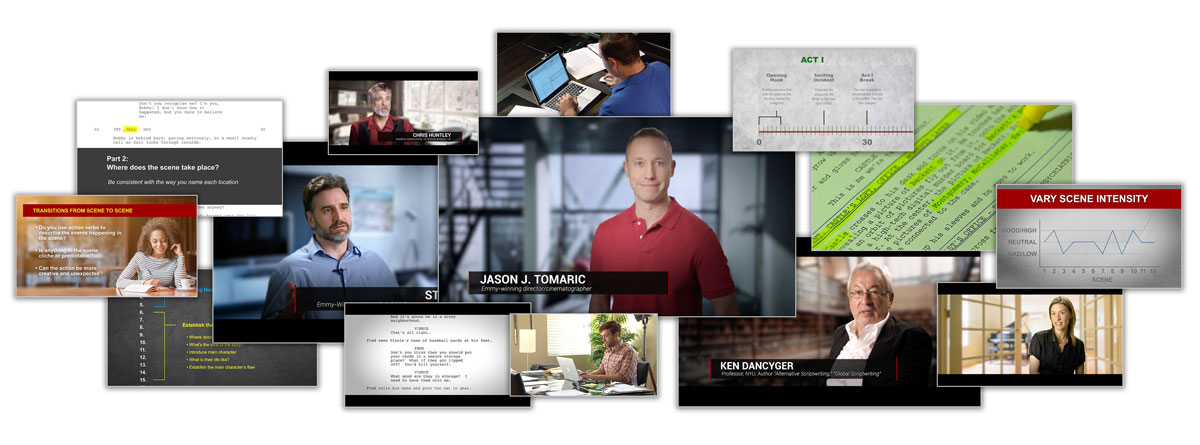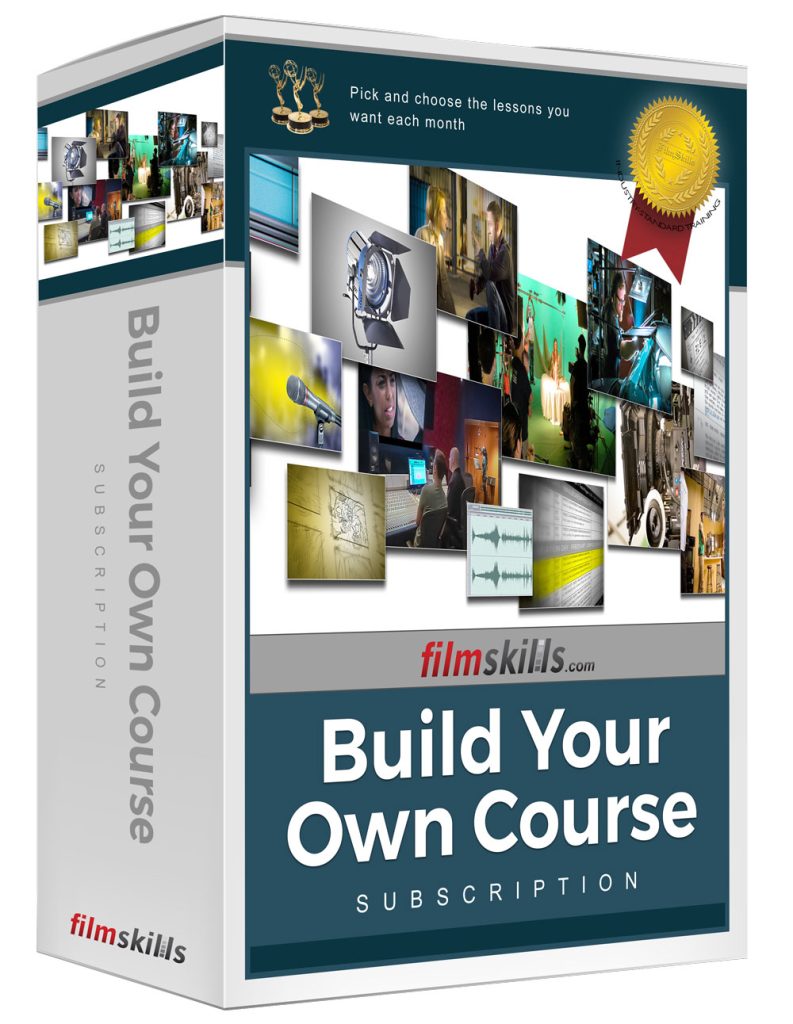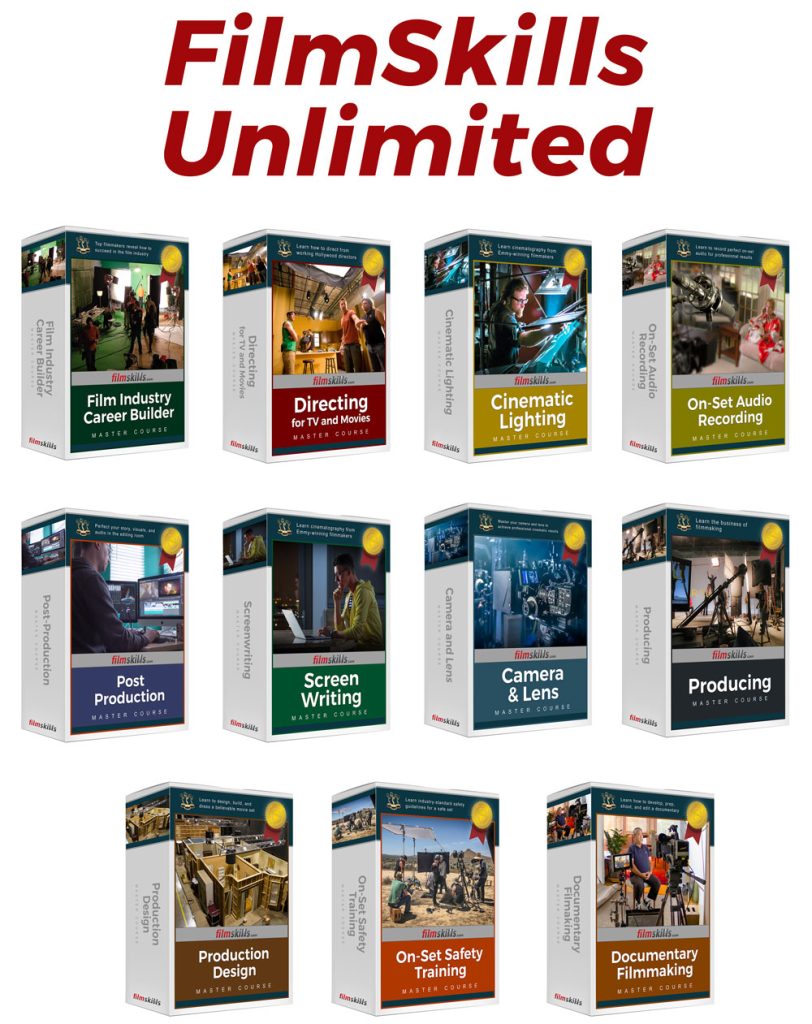The Complete Filmmaking Curriculum
Over a hundred Hollywood professionals helped build a comprehensive filmmaking curriculum.

Screenwriting
From the birth of an idea to the green light, this series takes you inside the writing process, and teaches the complete process of writing a feature-length screenplay.
Section 1: Getting Started
In this first section, learn how to get started by prepping your writing space, and identify a marketable idea.
Beginning the Writing Process
Congratulations! You’re ready to start writing your movie script, but where do you start? Before we jump into developing characters and discussing story structure, you need to prepare your tools and set-up a space to work. In this lesson, we will share some tips and tricks to helping you prepare to write your screenplay.
Working with a Writing Partner
Writers rarely approach a new script alone, but working with a writing partner can introduce its own challenges. In this lesson, we will show you tips and techniques for finding and establishing a good relationship with a writing partner.
Finding Story Ideas & Inspiration
In this lesson, the writers behind dozens of TV shows and movies, including Everybody Loves Raymond and Now You See It, plus studio executives, top Hollywood agents, and the Academy Award-winning Christ Huntley who defined the Hollywood story structure teach you how to find inspiration and develop your idea. (17:36)
Developing a Marketable Idea
Movie making is one of the most expensive and time-consuming art forms, and before you embark on months, even years of work, it’s wise to research the potential audience for your movie. In this lesson, I partnered with Emmy and Academy Award-winning writers, studio executives, and screenwriting professors to reveal dozens of tips and tricks to determining the market for your story concept. (19:40)
Section 2: Story Structure
In this first section, learn how to get started by prepping your writing space, and identify a marketable idea.
Beginning the Writing Process
Congratulations! You’re ready to start writing your movie script, but where do you start? Before we jump into developing characters and discussing story structure, you need to prepare your tools and set-up a space to work. In this lesson, we will share some tips and tricks to helping you prepare to write your screenplay.
Working with a Writing Partner
Writers rarely approach a new script alone, but working with a writing partner can introduce its own challenges. In this lesson, we will show you tips and techniques for finding and establishing a good relationship with a writing partner.
Finding Story Ideas & Inspiration
In this lesson, the writers behind dozens of TV shows and movies, including Everybody Loves Raymond and Now You See It, plus studio executives, top Hollywood agents, and the Academy Award-winning Christ Huntley who defined the Hollywood story structure teach you how to find inspiration and develop your idea. (17:36)
Developing a Marketable Idea
Movie making is one of the most expensive and time-consuming art forms, and before you embark on months, even years of work, it’s wise to research the potential audience for your movie. In this lesson, I partnered with Emmy and Academy Award-winning writers, studio executives, and screenwriting professors to reveal dozens of tips and tricks to determining the market for your story concept. (19:40)
Story Formats
Stories can be told in a number of different ways, and in this lesson, we’re going to look at how a story is structured in feature and short films, animation, commercials, documentaries, music videos, and corporate videos (17:18)
The 7 Plot Types
Every story that has ever been told, is being told, and will ever be told can be distilled into one of seven basic story lines. And every story is a variation of one of these plot types. In this lesson, we will explore each of these 7 plot types and how you can adapt them to your story. (20:01)
The Implication of Genre
Genre is the style that wraps around your plot structure. Each genre comes with its own story conventions, guidelines for the protagonist, scope of the antagonist, and plot structures. In this lesson, we look at the range of genres and how they impact your story and your ability to market your production. (16:40)
Three Act Structure
In this module, we’ll show you how to use the three act structure to properly pace your story, what should occur in each act, the length of each act, what happens at the beginning, middle and end of each act, and how to apply these techniques to your story. (39:00)
A-Story and Subplots
If you were to describe a movie in a few sentences, you would probably give me a great summary of the main plot of the story- “Raiders of the Lost Ark is about an archaeologist who goes in search of the Ark of the Covenant.” Or “Twilight” is about girl torn between two men – a vampire and a werewolf.” In both of these examples, you would be correct – but what you told me was what is part of what’s called the “A” plot, or the main storyline of the movie. Movies can also include several smaller stories called subplots, which help reveal character, push the story forward and ultimately support the A-plot. In this module, we’re going to look at how to effectively write both the A-plot and the subplots. (27:52)
Techniques to Improve Story Pacing
A good screenplay takes the audience on an emotional roller coaster, and one of the challenges facing each writer is how to keep the audience engaged through each and every minute of the story. In this module, learn literary techniques for maintaining strong pacing – especially through the second act. (14:39)
Techniques to Engage the Audience
Story pacing is critical to keep your audience engaged and interested in your movie. In this lesson, we’re going to reveal top literary tools you can use in your screenplay to keep people visually, emotionally, and psychologically engaged in your story. (23:11)
Watch a free lesson from this series
Section 3: Character Development
In this first section, learn how to get started by prepping your writing space, and identify a marketable idea.
The Protagonist
As you’re writing your screenplay, the most important character to write is the protagonist. But you have several choices – is he also the main character? Does the protagonist change or remain steadfast? How do you write a character the audience will care about? How can flaws help the protagonist solve the story problem? Knowing the answers to these question will help you craft a compelling character, so in this module, we’re going to explore techniques for writing a strong, multi-dimensional protagonist. (25:48)
The Antagonist
The antagonist has been classically referred to as the bad guy, the villain, or the adversary. But more properly defined, he, she or it is the literary opposite of the protagonist – the character who opposes the goals of the protagonist. In this module, we’re going to explore techniques for writing a strong antagonist, how to make him, her or it a real, multidimensional character. (26:00)
Conflict Types
Conflict in a story is everything – it defines the very purpose of the protagonist. We can divide the types of conflict into one of several categories – each category helping to define the antagonist’s role in the story. They are man vs. man, man vs. self, man vs. society, man vs. nature and man vs. the supernatural. So in this module, we’re going to explore these various types of conflict and how you can use them to craft a compelling antagonist. (30:47)
Supporting Characters
A movie is populated with dozens of other characters – many of whom have an influence on the protagonist and the antagonist. These supporting characters either help or hinder, compliment or compete with our protagonist and antagonist. They add vibrancy and excitement to the story, all while serving as a valuable literary tool for you as you write the screenplay. In this module, we’re going to explore the function of supporting characters. (31:52)
Character Archetypes
All characters can be broken down into eight different archtypes – now these are the basic ingredients of creating a character, so of course you can mix and match them to create more complex, unique characters. But every supporting character fulfills one of more of these roles. The eight archtypes are the protagonist and the antagonist, Reason, Emotion, The Sidekick, The Skeptic, the Guardian and the Contagonist. So, in this module, we’re going to explore the six archetypes that make up supporting characters.
Designing Personality and Building Backstory
The act of writing is much more than simply creating characters – it’s about writing real people with real fears, ambitions, strengths and weaknesses. Although you need to be able to create real, believable people, every choice you make when creating them needs to support the story. Who they are helps them confront the plot, learn more about themselves and ultimately succeed or fail. Their background gives them the tools and experienced they need to confront the conflict, and most importantly, their tragic flaw gives their story a personal arc. So, in this module, we’re going to discuss how to create personality and backstory. (29:06)
How to Write Natural Dialogue
One of producers’ biggest criticisms of a script is the weak, cliche dialogue. Learn how to make your script stand out with tight, engaging dialogue from working Hollywood experts. Emmy-winning Executive Producer of “Everybody Loves Raymond,” Steve Skrovan, Writer/Producer Mike Emanuel, Writer John Anderson, Writer/Script Doctor David Freeman and Emmy-winning Director Jason Tomaric share valuable insight into avoiding cliches and writing tight dialogue. (21:46)
Section 4: The Writing Process
In this first section, learn how to get started by prepping your writing space, and identify a marketable idea.
Title, Theme, and Log Lines
The title, theme, and log line are often the first exposure audience, producers, and agents may have to your story. But as a writing tool, they help you develop the plot thread and the heart of your story. In this lesson, we’re going to explore techniques for crafting a compelling title, developing a theme, and honing the log line to your screenplay. (15:02)
How to Write a Treatment and Outline
The treatment and outline for a movie is literally the backbone of the story, and the quality of your work in this phase can either make or break your script. Learn how to write an effective treatment and outline and simplify the process of writing the first draft. Working Hollywood writers teach you how to get the most out of this valuable writing tool. (19:30)
How to Format a Screenplay
Learn how to properly write and format the first draft of your script. This module is a complete guide that walks you through every step of how to format a screenplay. (18:13)
How to Write the First Draft
Now that your treatment and outline are complete, you can start writing the first draft of the script. This process is when you take each story beat and develop the action and dialogue of each scene. It’s a tedious process, and one that can be frustrating, but we will give you tips on how to make the first draft the best it can possibly be. (10:34)
Improve Your Rewrites
Once the first draft of your script is ready, the real work begins. Learn what to look for in the rewriting process, how to identify problem areas that may adversely affect the story and how to get the most out of each plot, character and line of dialogue. Emmy-winning Executive Producer of “Everybody Loves Raymond,” Steve Skrovan, Writer/Producer Mike Emanuel, Writer John Anderson, Writer/Script Doctor David Freeman, Emmy-winning Director Jason Tomaric and Jerrol LeBaron, president of the script brokerage site, inktip.com share industry tips and techniques on how to effectively rewrite your script. (13:55)
How to Market Your Screenplay
You’ve finished the script, now what? Working Hollywood writers and producers take you through the process of finding an agent or manager. Should you approach a producer instead? How do you deal with the studio Hollywood Reader? How do you cope with rejection? This module takes you through the intricacies of the Hollywood system and how to manage them. (21:18)
Your Screenplay and the Real World
Congratulations! Your screenplay is finished… or is it? When you sell or option your screenplay, agents, managers, and producers will often ask for multiple rewrites. In this lesson, we’ll show you how to manage feedback, how to protect your screenplay, grow your network, and improve your skills. (17:28)
Section 5: How to Use Final Draft Software
In this first section, learn how to get started by prepping your writing space, and identify a marketable idea.
Final Draft - Script Basics
Learn the basics of script formatting and how you can use Final Draft software to begin formatting your screenplay, including scene headers, action lines, dialogue, parentheticals, dual dialogue, and transitions. (26:05)
Final Draft - Using Templates
Learn how to use existing templates to format your Final Draft script into hundreds of popular formats including sitcoms, hour-long dramas, SNL skits, multi-camera shows, Broadway musicals, and novels. (13:02)
Final Draft - Story Organizing
Learn how to throw away the old note card and use Final Draft’s story organizing capabilities to organize your scenes, characters, and dialogue in an efficient way. (15:21)
Final Draft - Distributing Your Script
Learn how to export and distribute your script through Final Draft for both physical and electronic delivery, prepare your script for table reads, water mark, and learn about Final Draft on mobile devices. (17:37)
Final Draft - Tips, Tricks, and Utilities
Enhance your use of Final Draft with a number of tips and tricks. (28:00)
Final Draft - Production
Learn how to use Final Draft to manage script changes and revisions, how to lock pages, manage scene numbers, scene omissions and additions, and export reports that quickly analyze your script for production. (23:15)
Section 6: Professional Writing Tutorials
In this first section, learn how to get started by prepping your writing space, and identify a marketable idea.
The Changing Landscape of Television
Television has evolved from being a 3-network based medium, broadcasting their shows to a TV set in your living room to a massive content network accessible on wide range of devices – from home theaters to the phone in your pocket. Just as the technology has evolved, so too has the way stories are written to accommodate these new viewing habits. In this engaging FilmTalk, Emmy-nominated writer Pamela Douglas reveals incredible techniques for adapting your writing style for the new age of television. (34:36)
How to Become a Hollywood Writer
Emmy-nominated writer Pamela Douglas walks you through each step of how to begin your Hollywood writing career. Culminated from years of experience, Pamela’s insights give you an insiders perspective on how to build a successful career. (43:01)
Defining Comedy
When you think about comedy, what comes to mind? Slapstick, jokes, laughing? Well, comedy is much deeper and is a reflection on who we are as humans. In this FilmTalk, accomplished comedian Steve Kaplan provides shocking insight into comedy and how it relates to the human condition (29:36)
The Hidden Tools of Comedy
Comedy is often mistaken as being easy to write, act, and direct, but it may be one of the most difficult genres in which to work. In this brilliant FilmTalk, Steve Kaplan takes us on a journey into the hidden rolls of comedy to help us better understand what’s funny. (32:02)
Working in a Television Writer’s Room
Episodic television series hire a group of writers who work together to develop the character and story arcs, create the story lines, and write the scripts for every episode. Lead by the showrunner, the writers come together in what Hollywood calls “the writers’ room.” This collaborative workspace can be as politically-charged as it is creative and knowing how to work in the writers’ room can be the difference between a lucrative career and sitting on your couch. In this engaging FilmTalk, Emmy-winning writer Steve Skrovan takes us into one of the most creative rooms in the industry and shows you how to succeed in it. (24:40)


